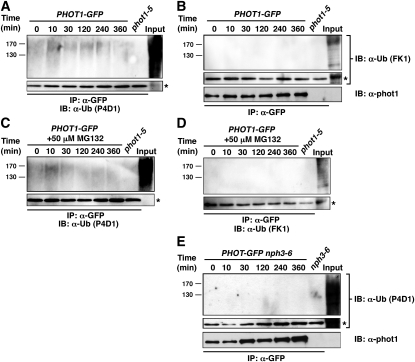Figure 8.
Low-Intensity BL Stimulates NPH3-Dependent Mono/Multiubiquitination of phot1.
(A) When the 26S proteasome is functional, ubiquitinated phot1 is detected by an antibody that recognizes both mono/multi- and polyubiquitinated proteins. Total cellular proteins were prepared from phot1-5PHOT1-GFP seedlings that had been mock irradiated (0 min) or exposed to low intensity (0.1 μmol m−2 s−1) unilateral BL for the indicated times. Total cellular proteins were also prepared from phot1-5 seedlings exposed to 120 min of low-intensity BL as a negative control (lane 7). With the exception of an aliquot from the phot1-5PHOT1-GFP sample that was retained as a positive control for total cellular ubiquitination (Input, lane 8), all samples were subjected to immunoprecipitation (IP) with anti-GFP antibodies (lanes 1 to 7). Ubiquitinated proteins were detected by immunoblot (IB) analysis with P4D1 anti-Ub antibodies. Bottom panel shows an extracted portion of the same blot containing IgG heavy chain (~50 kD) from the α-GFP antibody (asterisk) as a loading control for IP samples.
(B) When the 26S proteasome is functional, no phot1 is detected by an antibody that recognizes only polyubiquitinated proteins. Replication of experiment in (A) except that ubiquitinated proteins were detected with the FK1 polyubiquitin-specific anti-Ub antibodies. Middle panel represents a loading control as described in (A). Bottom panel shows a replicate blot probed with anti-phot1 antibodies to demonstrate that although ubiquitinated phot1 is not detected by the FK1 antibody (top panel), phot1-GFP is in fact immunoprecipitated effectively from phot1-5PHOT1-GFP seedlings grown under low BL conditions.
(C) When the 26S proteasome is inhibited, ubiquitinated phot1 is detected by an antibody that recognizes both mono/multi- and polyubiquitinated proteins. Replication of experiment in (A) except that seedlings were treated with 50 μM MG132 for 2 h prior to being mock irradiated or exposed to high-intensity unilateral BL. Bottom panel represents a loading control as described in (A).
(D) When the 26S proteasome is inhibited, no phot1 is detected by an antibody that recognizes only polyubiquitinated proteins. Replication of experiment in (B) except that seedlings were treated with 50 μM MG132 for 2 h prior to being mock irradiated or exposed to high-intensity unilateral BL. Bottom panel represents a loading control as described in (A).
(E) Low-intensity BL-dependent ubiquitination of phot1 is absent in the nph3-null mutant background. Total cellular proteins were prepared from Arabidopsis phot1-5nph3-6PHOT1-GFP seedlings that had been mock irradiated (0 min) or exposed to low-intensity unilateral BL (0.1 μmol m−2 s−1) for the indicated times (lanes 1 to 6). Total cellular proteins were also prepared from mock-irradiated nph3-6 seedlings as a negative control (lane 7). With the exception of aliquots from the phot1-5PHOT1-GFP samples that were retained as positive controls for total cellular ubiquitination (Input, lane 8), all samples were subjected to immunoprecipitation (IP) with anti-GFP antibodies (lanes 1 to 7). In the top two panels, ubiquitinated proteins were detected by immunoblot (IB) analysis with P4D1 anti-Ub antibodies. Middle panel shows an extracted portion of the same blot from the top panel containing IgG heavy chain (~50 kD) from the α-GFP antibody (asterisk) as a loading control for IP samples. Bottom panel shows a replicate blot probed with anti-phot1 antibodies to demonstrate that although ubiquitinated phot1 is not detected by the P4D1 antibody (top panel), phot1-GFP is in fact immunoprecipitated effectively from phot1-5nph3-6PHOT1-GFP seedlings grown under low BL conditions.

